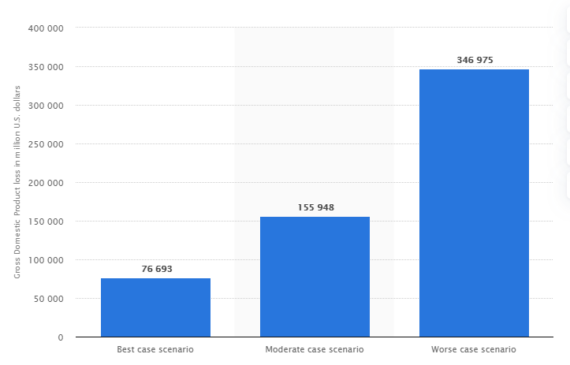Whenever any of the calamity befalls on the country it shakes its entire economy and survival. The impacts could have been severe which are followed by the rehabilitation and reconstruction and eventually returning to normalcy. The problem with the COVID-19 is that its disruptions are more prolonged and widespread, so as its economic losses to the global GDP. The forecasted global GDP growth for 2020 after the pandemic is 2.4% which is 0.5% less than the growth in 2019 i.e., 2.9%. This loss to the global GDP in turn affects the national economy of almost all the countries, as global trade is banned. Furthermore, the monetary loss to global GDP is shown in the figure below.

Impacts of COVID-19 on the National Economy
The COVID-19 has created uncertainties in any country and eventually in the world. Many of the countries aren’t aware of the fact that where this pandemic will lead them economically. For example, Pakistan still hasn’t reached the peak of COVID-19 cases. People and as well as the government aren’t aware of the situation which is about to arise in the future.
In every country which is affected by the pandemic, the factories are shut down and unemployment is going up, for example so far thirty million Americans have filed for unemployment in the past six weeks. People are consuming less and eventually, the companies are not investing further. The trade has reached a minimum level. Tourism is completely banned and countries like, Switzerland, Turkey, and many other European nations specifically are effected, as their National Income is very much dependent on the tourism industry. Large gatherings like weddings, corporate events, etc are prohibited in many of the highly infected countries, which in turn is contributing more to the downfall of the hotel and event planning businesses. So, all these issues are contributing directly to the National economy.
Reported by Xinhau, a Chinese News Agency:
The global economy could suffer between 5.8 trillion U.S. dollars and 8.8 trillion U.S. dollars in losses — equivalent to 6.4 percent to 9.7 percent of global gross domestic product (GDP).
Reconstruction and Rehabilitation of the National Economy
It is the stage where most of the countries are either on or heading to. The revival of the National economy starts from here. Some factories reopen at this stage and the circle of the economy starts rolling again. People start looking for jobs and businesses. The savings during the impact stage comes handy and people go out as work-related and important traveling resumes. But the gatherings and big events remain limited. This eventually is a step taken to ring the economic downfall to stop and get back into the direction of growth.




